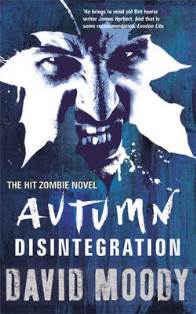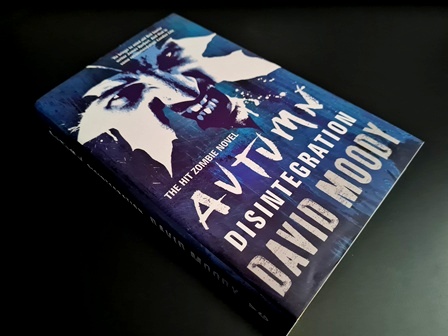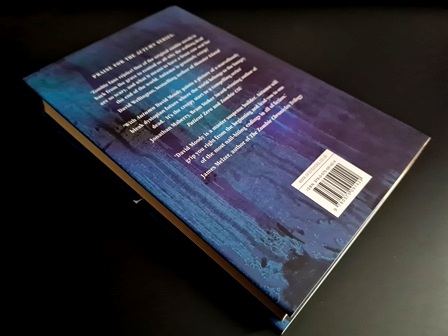
First published back in December of 2011, ‘Autumn: Disintegration’ formed British author David Moody’s fourth full-length instalment into his signature ‘Autumn’ zombie series (the fifth book after the companion book ‘Autumn: The Human Condition’ (2005)).
DLS Synopsis:
It’s been forty days since the vast majority of the world’s population succumbed to the plague. Since then the dead have risen and those remaining have clung together, hiding themselves away from the walking dead as best they can.
In a deserted housing block that was on the verge of being pulled down before the end of the world struck, a group of eleven tired and stressed survivors attempt to eke out an existence together. Having barricaded up all of the entrances and exits into the dilapidated housing estate, the group of survivors spend their days hiding away in one of the decaying flats; living off the supplies that they have managed to scavenge from the shops nearby.
However, the dead are beginning to congregate in increasing numbers on the other side of their hastily erected car barricades. Their numbers are swelling with each day; the dead drawn to the area by the constant sight and loud noise emitted by the survivors. And so in response to the growing problem, the gang of survivors take drastic action. Mass culls of the dead using hand weaponry and fire are brought into effect. But the numbers of the dead are too great, and with the attitude in the corpses beginning to show signs of changing, becoming increasingly controlled and aware of their surroundings, the time soon comes for the survivors to get out.
But there is another group of survivors close by who have taken a different approach to adapting to the presence of the undead. Instead of attacking and killing the dead whilst making hit ‘n’ run dashes to the nearby supermarkets for supplies, this second group of survivors have kept their heads down; hiding away in a large county hotel, keeping silent and staying hidden away. Furthermore, to encourage the dead away from their immediate vicinity, this second group have being playing music out from the nearby clubhouse – funnelling the dead away and into the fenced in golf course where their numbers have however swollen to worrying levels.
And when the first group arrive in their bus with the dead trailing behind, adjustment and compromise suddenly need to be made within the entire group. No longer is it easy to control the noise given off by them all, no longer is it easy to remain undetected by the dead, and with tensions mounting between the members in the two groups, something is bound to give. And when it does, all hell will break loose…
DLS Review:
For this fourth instalment into his post-apocalyptic zombie series, Moody has somewhat abandoned his previous characters and their own desperate storyline and instead rewound the clock ever so slightly and taken up the ‘Autumn’ story with a whole new group of survivors. As such, what is perhaps most surprising about this fourth full-length novel (fifth if you include the companion book ‘Autumn: The Human Condition’ (2005)), is that it stands on its own two feet as a story.
Instead of treading over old ground, Moody incorporates the gradual change in the undead - from bumbling directionless piles of rotting flesh, to an aggressive and increasingly self-aware threat – without getting too weighed down in the dead’s evolution. Having already witnessed this worrying transformation within the likes of ‘Autumn: Purification’ (2005), Moody effortlessly weaves the timeline for this transformation into the tale; bringing with it all the drama and tension that was so prevalent within the previous instalments.
The characters introduced into the novel are all what you might define as textbook David Moody characters. That is insomuch as each and every one of them appears so human, so ordinary and an everyday Average Joe. However, contending with clashing personalities and the enormous stress of the situation at hand – conflicts and rivalry are a very real problem.
Of the initial group of eleven survivors, Webb is by far the most interesting of characters. Rebellious and none-too-bright, on top of a purely blinkered approach to the entire zombie situation, Webb is a ticking timebomb that is just waiting to go off. Alongside Webb the characters if Jas, Greg Hollis and Stokes add plenty more aggression and testosterone into the mix; with Caron offering up the only hint of a compassionate stance.
What’s interesting (and a little surprising) is that many of the characters are far less defined and developed than in the previous Autumn books. Indeed, the likes of Driver (the bus driver who no one knows the real name for), Lorna and Harte are barely fleshed out at all. This is particularly unlike Moody, especially considering the incredible degree of characterisation shown throughout the entirety of his companion book to the series ‘Autumn: The Human Condition’ (2005). However, the loss in characterisation for these few characters amongst so many others with such clearly defined personalities and roles, actually has very little overall impact.
Another particularly interesting point to raise regarding this fourth full-length instalment is the increase in incredibly visceral gore. Here Moody has ramped-up the violence and nauseating zombie gore tenfold. With Jas swinging his chainsaw around in the thick of hordes of the undead, Webb clubbing the corpses with his nail-spiked baseball bat, and the others sporting an assortment of machetes, spades and other such weaponry – the pure savagery of the violence through much of the first half of the novel is jaw-dropping.
Marrying up the violence, the grotesquely visceral descriptions of the disintegrating corpses, and the rising tension of the situation – Moody delivers a novel that is rich in everything that makes for a damn fine post-apocalyptic zombie read. Okay, so there’s nothing that’s particularly ground-breaking in the novel. It plays within the same turf as many such tales, with a number of elements from ‘28 Days Later’ (2002) coming through particularly prominent within the novel. But it nevertheless works well in delivering an all-round entertaining and gripping read. And if we’re honest – that’s what we want most.
The novel runs for a total of 358 pages.

© DLS Reviews
Other ‘Autumn’ instalments:
- ‘Autumn’ (2001)
- ‘Autumn: The City’ (2003)
- ‘Autumn: Purification’ (2005)
- ‘Autumn: The Human Condition’ (2005)
- ‘Autumn: Disintegration’ (2011)
- ‘Autumn: Aftermath’ (2012)
- ‘Autumn: Dawn’ (2021)
- ‘Autumn: Inferno’ (2022)
- ‘Autumn: Exodus’ (2023)
- ‘Autumn: The London Trilogy Omnibus’ (2023)










